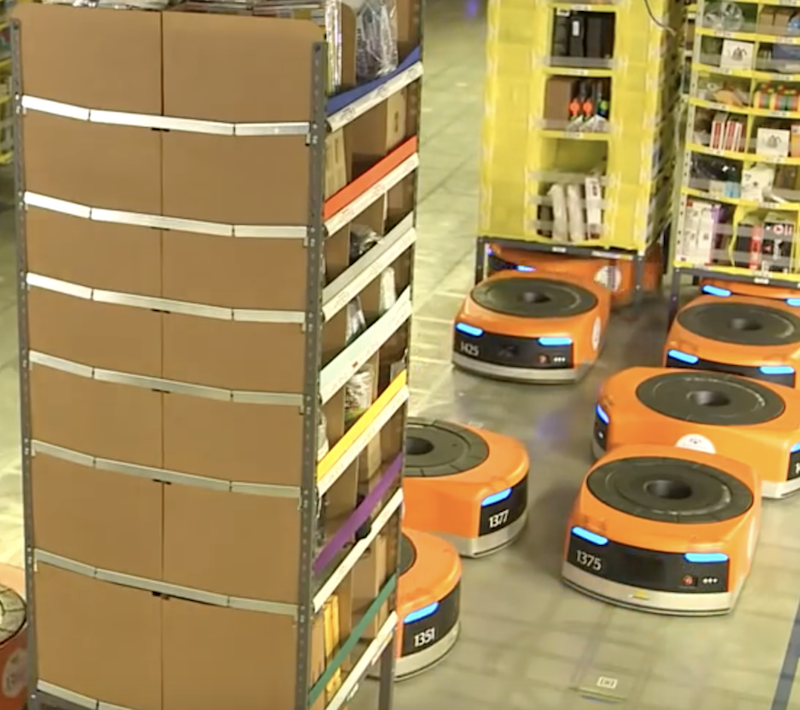Machine learning is enabling a new era of warehouse automation, as operators test artificial-intelligence-powered robots to help speed e-commerce orders.
An article posted earlier this week in the Wall Street Journal’s WSJ Pro section examines how logistics providers and retailers are deploying robotics to limit the number of steps their warehouse workers take and to execute more nuanced tasks long thought to be possible only by human hands.
Most warehouses still rely on human labor. But with the need to fill accelerating online orders, operators are looking for new, more efficient ways to manage distribution. Enter robotics: ROBO Global, a research and investment advisor, estimates that annual spending for warehouse and logistics automation, now at $46 billion, could surpass $75 billion by 2022.
Some examples of where the market may be headed, according to WSP Pro:
• XPO Logistics, with 1,529 locations and over 98,000 workers worldwide, is rolling out 5,000 AI-equipped robots that can deliver shelves full of products to workers.
• Rakuten Super Logistics—a division of the Japan-based online retailer Rakuten, with fulfillment centers in eight U.S. cities—is using robots to deliver bins full of products to workers who pick individual items for delivery.
• So-called collaborative robots that work in tandem with humans are also gaining popularity among warehouse operators, especially to manage seasonal workflows. XPO is using these robots to help guide workers through warehouse aisles, lighting up when they reach the next item to pick. Rakuten Super Logistics began using 40 “cobots” at its Las Vegas warehouse before the recent Christmas rush, and found they could handle increases in volume without adding temporary help.
Related Stories
| Aug 11, 2010
Nation's first multi-story green industrial facility opens in Brooklyn
The $25 million Perry Avenue Building at Brooklyn Navy Yard is the nation's first multi-level green industrial facility and the first building in New York City to incorporate building-mounted wind turbines. The wind turbines, along with rooftop solar panels, will provide electricity for the building's lobby and common areas.
| Aug 11, 2010
New York Mayor Bloomberg opens nation's first multi-story green industrial facility and announces new green manufacturing plant at Brooklyn Navy Yard
Mayor Michael R. Bloomberg, Deputy Mayor for Economic Development Robert C. Lieber, and Brooklyn Navy Yard Development Corporation Chairman Alan Fishman and President Andrew H. Kimball today opened the Perry Avenue Building, the nation's first multi-story green industrial facility at the Brooklyn Navy Yard. Mayor Bloomberg also announced the creation of Duggal Greenhouse, a 60,000-square-foot LEED Platinum certified facility.
| Aug 11, 2010
Jacobs, Holder Construction top BD+C's ranking of the nation's 50 largest industrial building contractors
A ranking of the Top 50 Industrial Contractors based on Building Design+Construction's 2009 Giants 300 survey. For more Giants 300 rankings, visit http://www.BDCnetwork.com/Giants
| Aug 11, 2010
AECOM, Arup, Gensler most active in commercial building design, according to BD+C's Giants 300 report
A ranking of the Top 100 Commercial Design Firms based on Building Design+Construction's 2009 Giants 300 survey. For more Giants 300 rankings, visit http://www.BDCnetwork.com/Giants
| Aug 11, 2010
PCL Construction, HITT Contracting among nation's largest commercial building contractors, according to BD+C's Giants 300 report
A ranking of the Top 50 Commercial Contractors based on Building Design+Construction's 2009 Giants 300 survey. For more Giants 300 rankings, visit http://www.BDCnetwork.com/Giants







